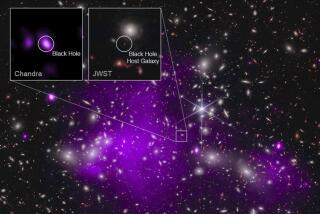‘Stripped’ black hole could be a rarely seen phenomenon, study says
Even black holes can lose a little glitter. Scientists studying a galaxy containing two black holes have found that one of them seems to be missing the usual crowd of stars surrounding it – a hint that it may be an elusive astrophysical object: an intermediate-mass black hole.
The findings, presented at the 227th American Astronomical Society meeting held this week in Kissimmee, Fla., and recently published in the Astrophysical Journal, could shed light on the evolution of the supermassive black holes that are thought to anchor virtually every large galaxy in the universe.
Finding a galaxy like SDSS J1126+2944, which contains a pair of such sizable black holes, is quite rare. It’s thought to be the result of two galaxies crashing into each other, merging into a new whole with two holes.
See the most-read stories in Science this hour >>
“I’ve spent a career working on how to find these things, and there aren’t very many of them known – there’s only 12 of them known,” said lead author Julie Comerford, an astrophysicist at the University of Colorado-Boulder.
It wasn’t long before Comerford and her colleagues noticed something quite strange about this pair of singularities. One of them was surrounded by the thick entourage of stars that typically surrounds a supermassive black hole, but the other one looked oddly bare, almost stripped, with 500 times fewer stars than its more popular peer.
There are two possibilities for this imbalance, Comerford said. It could be that because of the particular dynamics of the violent merging of two galaxies, one of the supermassive black holes was stripped of its stars. But that would have to be an extreme event for a supermassive black hole to lose that many stellar companions.
But there’s another possibility: The “naked” black hole could actually be a smaller, rarely seen object called an intermediate-mass black hole. While this more modest object would probably still have had some of its stars ripped away, the loss would have been far less extreme because the black hole would have started out with a smaller stellar entourage to begin with.
Black holes are the corpses of collapsed stars that warp the surrounding space-time, capturing anything, including light, that dares cross its event horizon. These objects seem to be divided into two camps: stellar black holes, which are thought to result from the death of smaller stars and which can weigh up to 30 suns or so; and supermassive black holes, which can hold the mass of many millions or even billions of suns.
Join the conversation on Facebook >>
There doesn’t seem to be much lying in the vast gap between these lightweights and heavyweights – which perplexes scientists, who are trying to understand the evolution of supermassive black holes, which lie at the heart of large galaxies (including our own Milky Way). How did these gargantuan objects come to be?
Intermediate-mass black holes, with masses in the range of 100 to a million suns, could offer an answer, Comerford said. It’s possible they were the seeds of the supermassive objects we see throughout the cosmos today.
“That’s why intermediate mass back holes are interesting to find, because they’re sort of a missing evolutionary link in the chain building up to supermassive black holes,” Comerford said.
In recent years, astronomers scanning the heavens have discovered a few (very few) so-called intermediate-mass black holes, which might offer some of the missing links in that chain. But they’re devilishly difficult to detect and confirm.
If the stripped black hole is in fact one of the intermediate-mass variety, studying it could give scientists fresh insight into the evolution of these strange phenomena. Comerford says she’ll have to observe it with a radio telescope and an X-ray telescope at the exact same time to determine whether it’s the real deal.
Follow @aminawrite on Twitter for more science news and “like” Los Angeles Times Science & Health on Facebook.
MORE FROM SCIENCE
Single moms are the most sleep-deprived people in America, report says
Losing weight: There’s a good way and a bad way, and the bad way won’t help
Unlucky Tasmanian devils suffer not one, but two kinds of transmissible cancer






